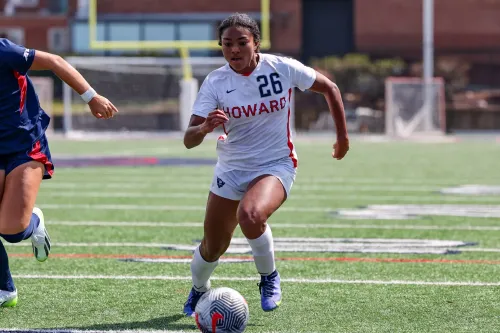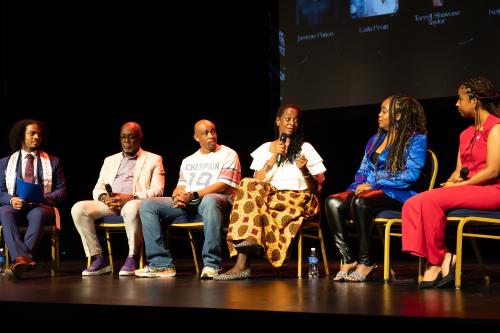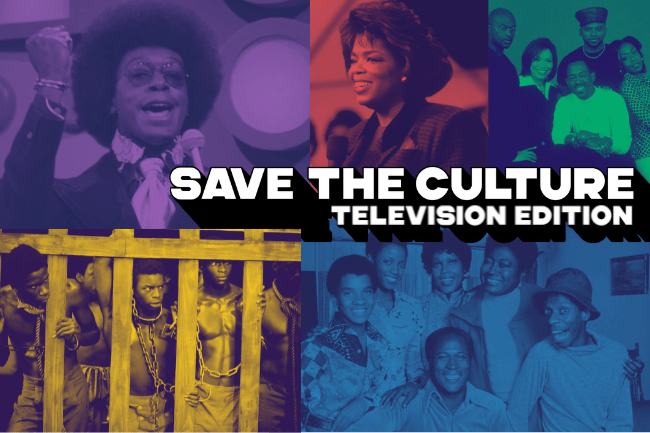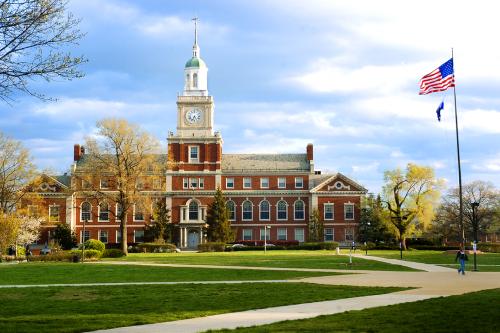The television characters and shows we watch are with us in our homes every day. The characters grow up with us and help us navigate the complex emotions and experiences we all live through. Television shows reflecting the Black experience have been a staple in the ever-evolving American TV landscape and illuminated for audiences a full picture of what life in America truly looks and feels like.
As part of our SAVE THE CULTURE series, we have selected 20 of the most essential television series since the medium’s invention early in the 20th century. This list looks at all the ways television has shaped the culture. These shows launched the careers of entertainment legends and represented the entire range of the Black experience on the small screen. This article represents part one of this list of 20.
With support from Sheryl C. Johnson-Ross (B.A. ’86), associate professor in the Cathy Hughes School of Communications (CHSOC) and Jennifer Thomas (B.A. ’88), associate professor in the Department of Media, Journalism and Film and Director of the Annenberg Honors Program, we explain why these shows have persisted over time and will continue to have relevance in the next century. The following collection highlights essential TV shows whose cultural and historical significance transcends their eras. We kick off the list with a show so foundational to the modern television landscape, that sitcoms have been chasing its success for the last 40 years. Bill Cosby created a catalog of television shows that changed the way that Black people are perceived in popular culture and opened the door to new opportunities for Black creatives in Hollywood.
The Cosby Show | 1984-1992 | NBC
“The Cosby Show” focused on the lives of the Huxtables, an upper-middle-class Black family in Brooklyn. It launched the careers of Phylicia Rashad (B.F.A. ’70, D.H. ‘09), Lisa Bonet, Malcolm Jamal-Warner, and others. Often referred to as the biggest television hit of the 1980s, the show created a blueprint that Black sitcom creators have followed since. “The Fresh Prince of Bel-Air,” “My Wife & Kids,” “Moesha,” and others adapted the show’s format to achieve their own success and become iconic shows. “At the time, there wasn’t a single sitcom in the Nielsen top twenty, and many in the TV industry had declared the format ‘dead,’” writes Mark Whitaker, the author of “Cosby: His Life and Times,” for Time. The show went on to dominate TV for the rest of the decade, landing in the top spot for five straight years and pulling all the sitcoms that came on after it into the top 10.
“Seeing a successful Black family with two parents and unique but curious and kind children, reminded me of my own family,” said Thomas. “The show was in its heyday when I was an undergrad at Howard, pre-cable TV. The show would air at 8 p.m. on Thursday’s during the Howard University Gospel Choir’s rehearsals, after which Thomas would race to any TV she could find to watch. At the time, Bill Cosby was America’s favorite TV dad and when I was selected as Miss Howard in 1987, he made a special appearance during the Homecoming game against Morehouse at halftime. Our picture was a Jet Magazine Photo of the Week.”
In creating the show, Bill Cosby (LL.D. ’89) was determined that it would be a realistic portrayal of a Black family dynamic and speak honestly to the experiences of Black children. While the show was still in development, he reached out to Dr. Alvin Poussaint, a Harvard psychologist specializing in minority children. While Cosby was busy making sure the show was funny, Poussaint read scripts to make sure they reflected genuine child psychology and family dynamics (Poussaint did the same job on spinoff “A Different World”). The show showcased an aspect of Black life that was not yet mainstream in popular media. A Black narrative focused on education, the arts, and respectability.
“Theo's character was especially notable in that he was a young African American man who was thoughtful and intelligent — just as most of us in the Black community know our young men to be,” said Thomas. “It was important for the general public to see these images and for them to be relatable. This show did that and more.”
“The Cosby Show changed the way Black families were viewed and depicted on television,” said Johnson. “Bill Cosby’s character, Cliff, was a doctor and Phylicia Rashad’s character, Clair, was a lawyer, and they were raising five children with positive family values. The show provided a positive reflection of what we, as Black Americans saw in our own families and challenged a lot of damaging stereotypes of Black people that were pervasive at the time. The emphasis on education and pride in our culture was huge and it was a launching pad for actors and actresses who went on to do great things.”
The Oprah Winfrey Show | 1986-2011 | King World/CBS
When Oprah Winfrey (D.H. ’07) became the host of “AM: Chicago” in 1986, she introduced a daytime talk show format that was more empathetic and attuned to contemporary culture than the gossipy format that ruled the landscape. Winfrey tackled issues like drug addiction, racism, and sexual abuse (including her own personal experiences with it) to uplift her audience and create an environment of compassion. In a 2001 Time magazine interview Winfrey said “[There] is a commonality in human experience … If it’s happened to one person, it has happened to thousands of others.”
Younger generations don’t appreciate the impact that the “Oprah Winfrey Show” had. She was a master journalist, a master interviewer, and tackled every topic known to man. With the show, Winfrey showed others all that could be possible in the world of television. She was the first Black woman to host and produce her own syndicated show. As owner of the show, Winfrey used her power to promote Black voices and platform issues that may have been off limits had it been under the control of a major network. “It was doing so well from a ratings perspective and revenue perspective that she had more liberty than a lot of other people would have because of the money that it amassed,” said Johnson.
“When Oprah was gaining popularity in the '90s, I was working in television news as a producer. Because her show was so successful at 4 p.m., our station created a 5 o’clock newscast that would come on immediately following her show to get her viewers to watch. Around the country, 5 o’clock shows were being created for the first time because of the Oprah Winfrey show. Generally, in local news, you would have a noon, 6 o’clock, and a 10 o’clock show. Everybody was trying to get something on to follow her show,” said Thomas.
“She earned over 2 billion dollars during her show’s run, said Johnson. “The advertising revenue earned was over $300,000 per ad placement. From that, she was able to fund her production company Harpo Studios, which laid the foundation for OWN Network. Local stations who picked up her show were able to run premium prices for their ad spots during that time slot. The revenue she was generating for herself, and television networks, was unheard of for daytime television. She amassed for her show what some shows were getting for primetime advertising rates.
She launched the careers of Dr. Phil, Dr. Oz, Suze Orman, Rachael Ray, Nate Berkus, Iyanla Vanzant, and Gayle King.
Roots | 1977 | ABC
“Roots” was an eight-episode miniseries adapted from the 1976 Alex Haley (D.Litt. ’73) novel “Roots: The Saga of an American Family.” Starring legends of Black American film and television, Levar Burton (D.H.L., ’25) in his first role, Lou Gossett, Jr., John Amos, Ben Vereen, Leslie Uggams, Maya Angelou (D.Litt., ’85), Cicely Tyson (D.H.L., ’86, D.Litt., ’16), and more, “Roots” was a groundbreaking story of American slavery. It follows West African teenager Kunta Kinte (played by Burton and Amos) on his journey from being a member of a warrior tribe in Africa, to his life as an enslaved person in the United States. The series spans 100 years to where we see Kunta’s grandson gaining freedom. Roots was explicit in its depiction of the horrors of the American chattel slavery system, giving the public a view of Black life that opposed the light and fun stories told on shows like “The Jeffersons” and “Sanford and Son.”
“Roots challenged American television by encouraging the nation to face the generational trauma of slavery through Black ancestors' resilience,” said Johnson. “It was more than a simple TV event; it became an educational tool — demonstrating to African Americans that their history was visible and a compelling story of survival, heritage, and identity that warranted national recognition and remembrance.”
Airing eight nights in a row, this television event was one of the highest rated programs in television history with 100 million viewers tuning in for the final episode. The final episode holds the record as the third highest-rated episode for any type of television series and the second-most-watched series finale in American television history. All its episodes rank in the top 100 most watched television broadcasts of all time. The miniseries was watched by an estimated 140 million viewers total (more than half of the U.S. 1977 population of 221 million — the largest viewership ever attracted by any type of television series in U.S. history as tallied by Nielsen Media Research) and averaged between 66% and 80% viewer share of the audience. “Roots” was nominated for 37 primetime Emmy Awards and won nine. It also received a Peabody Award and a Golden Globe.
"Personally, the series opened my eyes to what my parents shared about slavery,” said Thomas. “I was very emotional watching it, and recall having conversations about the series with my father, a Baptist pastor whose family migrated from the South to the Midwest, and mother, a schoolteacher from the South. ‘Roots’ lit a fire in my desire to learn more about my own family tree.” She continued, “In my elementary school in Omaha, Nebraska, I recall speaking out in class and even debating with a (white) teacher about Black history. The series was more much more than entertainment; it provided pride and determination for me as a young girl to be proud of my race and my Black skin.”
Soul Train | 1970-2006 | WCIU-TV
“Soul Train” is a staple of Black American musical culture. Created in 1970 by Don Cornelius, the show originated the ever-iconic Soul Train line and launched the careers of the Jackson 5, Teena Marie, and others to new heights. Syndicated in 1971, “Soul Train” started out as a local Chicago musical program featuring local Black talent and evolved into a cultural powerhouse platforming contemporary musical superstars, Black and white. It remains the longest first-run syndicated television series in broadcast history. A key partnership with Johnson products, the makers of the Afro Sheen hair care brand, led to its status as a radical show for the times, slotted next to commercials that proudly showcased natural hairstyles in spite of the pressure for Black hair to conform to European standards. It was appointment television showcasing the beauty of natural Black hairstyles and the newest dances and fashion.
Good Times | 1974-1979 | CBS
“Good Times” focused on the Evans Family, a Black family living in the Cabrini-Green public housing project in Chicago’s South Side. A spinoff of “Maude” (itself a spinoff of “All in the Family”), where Esther Rolle played Florida Evans, Maude’s housekeeper, “Good Times” gave audiences a realistic look at Black life in the projects. While on the surface, it may seem to be reinforcing stereotypes about Black people by placing them in poverty instead of in positions of power and professional success like many of the other shows on this list, “Good Times” showed its audience that Black people in the projects were just like people living anywhere else. They weren’t drug dealers and criminals, but hardworking, talented, intelligent people trying to better their circumstances.
Esther Rolle and John Amos were protective and loving parents who worked hard to give their children everything they could afford. The children, painter JJ, dancer Thelma, and future lawyer and civil rights activist Michael, exemplified a typical sibling dynamic — always teasing each other and getting into mischief, but ultimately showing us a strong family unit. The family’s dynamic with their friends, handyman Bookman, next-door neighbor Willona Woods, and later her adopted daughter Penny (played by Janet Jackson) showcased the importance of community and finding joy in the face of adversity. No matter what anyone in the show was going through, there was always a village of people looking to lift them up and help them out, even if that village didn’t have much to give.
More than just an entertaining sitcom, “Good Times” was a platform for discourse on poverty, racism, and the pursuit of the American dream. “Good Times” gave audiences a realistic view of a working-class American family and changed the popular American perspective on those experiences.
Sanford and Son | 1972-1977 | NBC
When “Sanford and Son” premiered, produced by legendary television screenwriter and producer Norman Lear (“All in the Family,” “The Jeffersons,” “Maude,” and “Good Times”), it was the first show with a primarily Black cast since “Amos ‘n’ Andy” in 1951. An adaptation of British sitcom “Steptoe and Son,” the show focused on father-and-son junkyard owners, Fred and Lamont Sanford. Set in the Watts neighborhood of Los Angeles, the show focused on Fred and Lamont’s relationship dynamic. Fred was the wisecracking father who spent his time reading his newspaper or watching soap operas while his son spent the day out on the road looking for junk. He always had a get rich quick scheme going and constantly bickered with his friends and family, especially his bible thumping sister-in-law, Esther. The show’s humor often echoed the style of Lear’s “All in the Family,” using racial prejudice as a comedic device.
“Sanford and Son” was an almost instant hit, earning a 52 percent share of the viewing audience during its pilot episode and landing in the Nielsen top ten for nearly all its six seasons on the air. It was also the first black sitcom to make it to its 100th episode.
The show turned Redd Foxx, a raunchy comedian who cut his teeth on the chitlin circuit in the 40s and 50s, into a household name before it was typical for stand-up comedians to land their own sitcoms. Foxx and Lear were adamant about making the show a realistic depiction of Black life and omitting the typical racial stereotypes. In the third episode, Sanford uses the n-word in a scene Foxx insisted was necessary to portray a realistic Black man. At a time when escapist television shows ruled, “Sanford and Son” started a trend toward more realism in television.
In Living Color | 1990-1994 | Fox
“In Living Color” launched the careers of some of the most prolific comedians of the modern era and had a cultural impact that touched music, film, television, and even the Super Bowl. In 1992, back when the Super Bowl halftime show featured local high school bands and amateur performers, “In Living Color” planned its own halftime show. The special episode attracted 28 million viewers, and Super Bowl ratings plummeted in the second half. The following year, the NFL answered by enlisting the legendary Michael Jackson to reinvent the Super Bowl Halftime Show.
The hugely popular show was created by Kennan Ivory Wayans, the second oldest of 10 children from Manhattan, New York. Wayans attended Tuskegee University for engineering but dropped out one semester before graduation to pursue improv comedy back in New York. With his siblings, Damon, Kim, Shawn and Marlon, Wayans created a revolutionary comedy sketch show that tackled race, politics, and pop culture unapologetically. The show’s writers were always looking to push the envelope with their comedy. It was inspired by “Saturday Night Live” (Keenan even auditioned) but pushed the boundaries far beyond anything that had been seen on television before with sketches like “The Wrath of Farrakhan” and “Jews on First.” The comedians on the show were the target of extreme backlash from social justice organizations and viewers deeming the show racist and crude. The reactions only fueled Wayans to push even further.
“Men on Film,” played by Damon Wayans and David Alan Grier, saw two stereotypical gay Black men confidently and unapologetically make commentary on the latest films. The sketch, although stereotypical, opened the door to LGBTQ acceptance in mainstream media.
Similar to “The Arsenio Hall Show,” “In Living Color” was also a platform for hip-hop. Busta Rhymes made his first television appearance on the show, and the creators infused hip-hop music and culture into every element of the program, from the theme song to the dance breaks.
“In Living Color”, launched the comedy careers of all the Wayans, Tommy Davidson, David Alan Grier, Jim Carrey, Jamie Foxx, Chris Rock, Kelly Coffield, T’Keyah Crystal Keymáh, Kim Coles, Anne-Marie Johnson, writer Larry Wilmore, and more. The dance troupe ‘Fly Girls’ launched the careers of Jennifer Lopez, Rosie Perez, Carrie Ann Inaba, and Laurieann Gibson. The show won an Emmy Award in 1990 for Outstanding Variety, Music or Comedy Series.
The Arsenio Hall Show | 1989-1994 | CBS
One of the most iconic moments on "The Arsenio Hall Show" was Bill Clinton's appearance playing the saxophone in 1992. While behind in the presidential race, Clinton's appearance on the talk show earned him extreme favor in the Black community and the honorary designation as "the first Black president." While this is the most well-known moment of the show, its impact on television is much greater.
In 1989, fresh off the success of “Coming to America,” Arsenio Hall became the first Black person to host a late-night talk-show. The show was syndicated six days a week in 95% of U.S. markets. Arsenio approached the show with a vision to make it a “talk show for the MTV crowd,” expanding the late-night audience to urban viewers, college students, and the like. Six months after its premiere, its ratings had surpassed both David Letterman and Pat Sajak’s late night shows and was beginning to creep up on Johnny Carson. He gave a platform to younger white and Black artists like Bobby Brown, Duran Duran, and Lisa Lisa & Cult Jam, who couldn’t get booked on a traditional talk show. His egotistical and sometimes raunchy persona took late night by storm and had stars like Farrah Fawcett, Anita Baker, and Tony Danza calling to be on the show. He demanded to be given the role of executive producer so that he could do the show the way he wanted to do it and fail or succeed on his own terms. Hall was determined to be himself and infuse his blackness and his own personality into every element of the show, not shying away from using slang or throwing his feet up on the table. He called his band “The Posse” and his crowd, who cheered by pumping their fists and barking rather than clapping, “The Dog Pound.” He broke legendary R&B artists. Mariah Carey, En Vogue, and TLC all made their first television appearances on Arsenio.
His most transformational impact, however, was in introducing the older mainstream audience to hip-hop when nobody else was willing to do so. His idols Don Cornelius and Oprah Winfrey even shied away. Not only did he have young hip-hop artists like Ice-T and NWA perform, but he also had them on as guests and gave them an opportunity to speak on gang violence in their communities and other issues. He gave his audience a more insightful view into what these hip-hop stars were rapping about. His impact was so essential to the culture that for his final episode, Queen Latifah asked to plan a surprise segment. She recruited a bevy of hip-hop superstars, which included Wu Tang Clan, MC Lyte, A Tribe Called Quest, Naughty by Nature, Fu-Schnickens, Pete Rock, CL Smooth, Mad Lion, Phife Dawg, Das EFX, KRS-One, and Yo-Yo to honor him with a surprise performance. They infused Arsenio into their rhymes, thanking him for how he embraced hip-hop on the show. In 2019, Chip Fu of the Fu Schnickens told Tim Einenkel “If it wasn’t for Arsenio, you wouldn’t have known about a lot of artists. So, to hear that they were canceling his show, it struck a nerve with the Hip-Hop community.”
Following his success, late night shows like Jay Leno’s installment of “The Tonight Show,” as well as Jimmy Fallon’s copied Hall’s formula, targeting a younger, hipper audience and making the house band a staple of the show’s identity.
Martin | 1992-1997 | Fox
After three seasons of hosting Def Comedy Jam and playing roles in iconic Black films “House Party” and “School Daze,” Martin Lawrence developed “Martin” with HBO. Debuting three months after “The Cosby Show” ended, “Martin,” at its core, explored gender roles and relationships in the Black community. Set in Detroit, the show is centered on Martin, the loud, brash radio host of WZUP, his girlfriend Gina (Tisha-Campbell), her best friend and Martin’s nemesis Pam (Tichina Arnold), and his best friends Tommy (Thomas Mikal Ford) and Cole (Carl Anthony Payne II), as they navigate careers, romantic relationships, and friendships. Martin’s back-and-forth verbal sparring with Pam reinvented the dynamic seen between George and Florence in “The Jeffersons” and Fred and Esther in “Sanford and Son.”
Martin was a hyper masculine, often insecure man while Pam was an independent Black woman who refused to be diminished by Martin’s fragile ego. His friends Tommy and Cole also explored contemporary Black male identity. Tommy’s mysterious employment status spoke to instability in urban communities while Cole’s perpetual cohabitation with his mother spoke to a co-dependency and unwillingness to fully step into adulthood. The women on the show embodied a different identity. Gina and Pam were successful corporate public relations agents. Their positions challenged the stereotypical gender roles present in romantic relationships and shaped the narrative of the show.
With “The Simpsons” as a Thursday night lead-in, “Martin” portrayed a story of young Black love and reflected experiences that young people could relate to. From moving in together, to meeting the parents, and opening joint checking accounts, Martin brought viewers along for the entire Black love journey.
Throughout the series, Lawrence played nine other characters including his next-door neighbor (inspired by his sister) Shenehneh, aging local pimp Jerome, policeman Otis, and snotty-nosed neighborhood kid Roscoe, bringing plenty of outrageous comedy to each season.
Eyes on the Prize | 1987-1990 | PBS
Using personal interviews and archival footage, “Eyes on the Prize” chronicles the major events of the Civil Rights Movement of the 1960s. The show’s 14 episodes span major events from the Montgomery Bus Boycott in 1954 to the election of Chicago’s first Black mayor in 1983. Henry Hampton, a participant in the Selma to Montgomery marches and the show producer, began working on the show in 1978. At a time when the majority of the films being made about the Civil Rights Movement were focused on Martin Luther King, Jr. and were being made by white people, Hampton was determined to put the ordinary Southern Black people who drove the movement into the forefront of their own story. Nobody who was not actually a participant in the specific events being covered in the show was interviewed to be on camera.
The documentary includes interviews with Coretta Scott King, Rosa Parks, and Roy Wilkins as well as lesser-known activists and opponents of the movement. It is the most comprehensive document of the Civil Rights Movement.
Unfortunately, part two of “Eyes on the Prize” (1964-mid 80s), is unavailable on streaming due to various right restrictions. It is only available to educational institutions. The series won two Peabody Awards, six Emmy Awards and was nominated for an Academy Award for Best Documentary Feature in 1988.
###
Related Story

Keep Reading
-

-
 News
NewsDuring Chadwick Boseman Day, Students and Alumni Honor the Late Actor and Celebrate Howard Artists
Sep 2, 2025 6 minutes
Find More Stories Like This
Are You a Member of the Media?
Our public relations team can connect you with faculty experts and answer questions about Howard University news and events.
Submit a Media Inquiry


